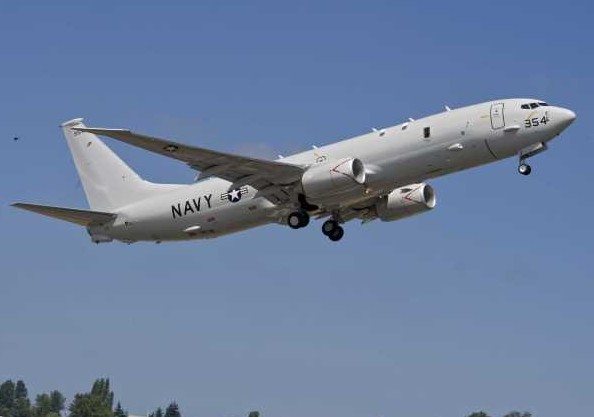The Navy received the final production P-8A Poseidon aircraft of 2014 on Jan. 8 marking 21 deliveries to fleet operators in Jacksonville, Fla.
“Boeing last month delivered the eighth P-8A Poseidon of 2014, completing all planned deliveries to the U.S. Navy on or ahead of schedule,” said Cmdr. Tony Rossi, P-8A Poseidon deputy program manager and integrated product team lead. “ Due to the holiday, this particular delivery flew from Seattle to Jacksonville yesterday where it joined other P-8As being used by Navy crews. This year, we will begin to deliver low rate initial production Lot 4 aircraft to fleet squadrons.”
As the naval fleet forces transition from the P-3C to the P-8A, Sailors in the Maritime Patrol community will use this aircraft for training and operational missions. This delivery adds the 21st aircraft to the Navy’s current P-8 inventory.
This time last year, Patrol Squadron 16 (VP-16) and their P-8As embarked on the inaugural operational deployment to Japan in the 7th Fleet Area of Responsibility. During their maiden P-8A deployment from December 2013 to July 2014, VP-16 flew 369 sorties, accounting for over 3,800 flight hours.
“Over the course of the VP-16 War Eagles deployment, they successfully executed over a dozen detachments to multiple countries, including Malaysia and Australia in support of the MH370 search and recovery efforts,” said Rear Adm. Matt Carter, Commander Patrol and Reconnaissance Group, which oversees the Navy’s maritime patrol community. “By every measure, VP-16 had a highly successful first deployment with P-8A, and the aircraft met or exceeded all expectations in regard to performance, speed, range, and reliability.”
While the War Eagles were on deployment, the P-8A Program received permission to enter full rate-production (FRP) in January 2014 and awarded the first FRP contract the following month. In February 2014, the Government of Australia announced acquisition approval for eight P-8As.
“The U.S. Navy and the Royal Australian Air Force (RAAF) cooperate closely in the execution of this international program, to the mutual benefit of both partners,” said Capt. Scott Dillon, Maritime Patrol and Reconnaissance Aircraft (PMA-290) program manager. “This cooperation is enhanced by the assignment of RAAF personnel directly to PMA-290 and to the U.S. Navy’s Maritime and Reconnaissance Fleet Replacement Squadron, VP-30, in support of P-8 acquisition and training efforts.”
On Aug. 14, the U.S. Navy awarded Boeing Defense and Security Systems an advance acquisition contract for the procurement of long-lead items for the manufacture and delivery of FRP Lot 2 P-8A aircraft for the U.S. Navy and RAAF. Dillon noted that the August contract award furthered the delivery of additional P-8As to the U.S. Navy and will deliver the initial set of P-8As to the Australian Government.
Following the contract award, P-8 program stakeholders received first-hand feedback from the initial squadron to transition and deploy with the P-8A. During the months of October and November, VP-16 conducted several road shows to debrief civilian and military leadership on the squadron’s deployment. The War Eagles’ commanding officer shared their P-3 to P-8 transition experiences with senior leadership at Chief of Naval Operations, Naval Air Systems Command, Commander of Patrol and Reconnaissance Group, Boeing and Spirit.
“We completed our first operational deployment to Japan and were very confident we had the right tools to do the job,” said VP-16’s commanding officer, Cmdr. Dan Papp, at the NAVAIR briefing to the PMA-290 workforce. “Our crews demonstrated that when you marry up a great aircraft with a well-trained crew, awesome things happen.”
According to Papp, when looking at the Poseidon program — whether it is the folks designing and building the aircraft or the young aviators flying the aircraft — there is a sense of pride, professionalism, and commitment to do a great job. He also explained that when the squadron was on their first operational deployment to Japan, “the crews knocked it out of the park” with the P-8A and characterized the Poseidon as a game changer.
“We put the aircraft to the test while on deployment. We tested our aircrew and logistics support, detachment after detachment. The Navy-Boeing team built us a reliable and dependable aircraft,” Papp said to the PMA-290 team. “We have a responsibility when our forward-deployed commander tells us to get out there and find that submarine or vessel in distress and we’ve got to be there within two hours … we got off the deck on time and 100 percent of the time we got there.”
As VP-16 continues to brief stakeholders on their transition, other squadrons will pick up where the War Eagles left off by transitioning from the P-3 and following in their footprints.
“The transition from P-3C Orion to P-8A Poseidon is progressing as planned and the following east coast squadrons have completed, or soon will, their transition to P-8A: VP-16, VP-5, VP-45, and VP-8,” Carter said. “VP-10 will begin their transition in February 2015. VP-26 will begin their transition in September 2015. All east coast VP squadrons are planned to complete their P-8A transition by February 2016.”
Currently, the Mad Foxes of VP-5 are on deployment with the P-8A. To date, VP-5 has flown over 2,000 hours — an operational tempo that has exceeded that of VP-16 — has executed twice the number of detachments in support of ongoing theater cooperation efforts.
“As we move into 2015, the U.S. Navy, Australia and P-8A industry teams will continue fleet introduction of the world’s most advanced maritime patrol and reconnaissance aircraft while simultaneously expanding the already impressive capabilities of the current design,” Dillon said.










